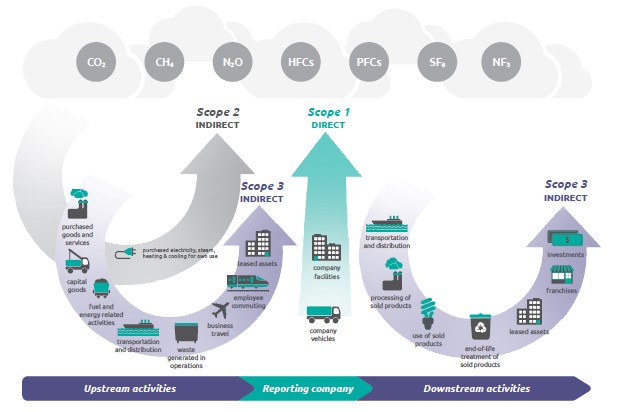- Greenhouse Gas Emissions
- Emissions Reductions
- Carbon Reduction
- Supply Chain
Improving Transparency and Disclosure of Scope 3 Emissions

This blog was coauthored by Ian Trim.
In a globalized world that needs to become climate neutral by 2050, companies are coming under increased pressure to take responsibility for the emissions resulting from goods or services they produce and sell. In this context, more and more attention is on those emissions that the company has little or no direct influence—Scope 3 emissions, which occur along an organization’s value chain. To reduce emissions upstream from Scope 3 emissions, the first step is to determine them as precisely as possible. For an ambitious emissions reduction target, the Science-Based Targets initiative calls on companies to include Scope 3 emissions in their targets if they account for more than 40% of the company's overall emissions.
Overview of Greenhouse Gas Protocol Scopes and Emissions Across the Value Chain

Source: Greenhouse Gas Protocol
Scope 3 Emissions from Suppliers Represent the Majority of Many Organizations’ Carbon Footprint
For many companies, a large proportion of Scope 3 emissions result from upstream activities. According to CDP Worldwide, supply chain emissions are more than 5 times greater than operational emissions on average. These arise, for example, from the procurement of emissions-intensive raw materials or complex logistics. To reduce these emissions in a targeted manner, a company must understand the split of its Scope 3 emissions, key suppliers, and what processes cause the emissions from its suppliers. Without a good understanding of the underlying sources of emissions, the development of a joint reduction strategy is difficult. The more diverse, complex, and global a supply chain is, the more time-consuming it is to obtain relevant emissions data. Often, suppliers have not yet dealt with the monitoring of their own emissions and must first learn basic things such as the collection of certain activity data and emissions factors.
A structured and transparent collaboration approach is of great advantage. This is optimally supported by an easy-to-use digital tool that ensures the smooth exchange of data and allows suppliers and customers to track developments in emissions at all times. One example of such a tool is Guidehouse’s sustainability management platform, Guidehouse PapayaTM. The platform allows all emissions-relevant data to be submitted directly to the company via an online portal tailored to the supplier's needs. At the same time, a supplier can identify its own emissions and hotspots then plan targeted reduction measures. Progress toward the emissions reduction target, agreed upon with the customer, can be tracked.
Scope 3 Emissions Disclosure Is Becoming a Mainstream Requirement
Beyond the actual identification of supplier emissions and corresponding measures to reduce them, the reporting of these emissions also plays an important role today. Investors and customers demand transparency about emissions along a company's entire value chain. Transparency is used to measure the credibility of companies and how serious they are about climate-protection efforts. Digital solutions like Guidehouse Papaya can be helpful here by offering reporting aligned with all common formats (CDP Worldwide, Global Report Initiative) at the push of a button.
By using appropriate digital solutions, it is possible to combine transparency, monitoring, and communication along the value chain while minimizing the effect on the environment. This will help companies improve supplier relationships, enabling them to implement effective Scope 3 emissions programs and reduce their overall climate impact.